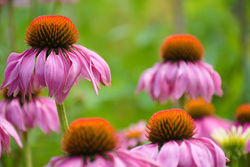Birth month flowers guide: Find your birth flower
- Lars Wildes
- Jan 28, 2023
- 4 min read
Birth flowers, also known as birth month flowers, are flowers associated with a specific month of the year. Whether you believe they have symbolic meanings or not, birth flowers are a beautifully unique way to show someone that you care and want to celebrate their special day.
Think of them as the personalized gifts of the flower world.
Each flower has its own characteristics and meaning attached. And even if it’s just for yourself, it’s fun to know which flower corresponds with your birth month.
Keep reading to discover the flower that represents your special someone (even if that special someone is yourself).
Birth flowers and their meanings
January: Carnation (Dianthus caryophyllus)

We start the year off with the carnation. This flower is associated with love, fascination, and distinction. It’s also said to symbolize a mother's love.
February: Violet (Viola spp.)

The month of love gets the violet as its birth flower. The violet is a symbol of modesty, faithfulness, and virtue.
March: Daffodil (Narcissus spp.)

The daffodil is connected to new beginnings and the arrival of spring. It’s also a symbol of hope, respect, and unrequited love.
Want to see more yellow flowers? Click here for vibrant yellow flowers that come back year after year.
April: Sweet pea (Lathyrus odoratus)

April showers bring… sweet peas. The sweet pea is associated with delicate pleasure and is a symbol of goodbye and gratitude for a pleasant time.
May: Lily of the valley (Convallaria majalis)

The lily of the valley is associated with the return of happiness and is also a symbol of sweetness and humility. It’s also dangerous. So be careful if there are cats or kids around.
June: Rose (Rosa spp.)

For June, it’s coming up roses. The rose is connected to love, secrecy, and beauty. The red rose is a symbol of romantic love, while the yellow rose is a symbol of friendship.
July: Larkspur (Delphinium spp.)

This is one of my favorite plants on the calendar. The Larkspur is associated with lightness and levity, and it’s a symbol of an open heart and strong bonds of love.
If purple is your color, take a look at the best purple perennials here.
August: Gladiolus (Gladiolus spp.)

For the end of summer, you get the gladiolus. The gladiolus is associated with infatuation and represents strength of character.
September: Aster (Aster spp.)

The aster is said to mean patience, daintiness, and love. Since most schools start back in September, the patience part makes a lot of sense.
October: Marigold (Tagetes spp.)

If you were born in October, your birth flower is the marigold. The marigold is associated with devotion and passion and symbolizes creativity and a love of life.
November: Chrysanthemum (Chrysanthemum spp.)

For the November babies, your flower is the chrysanthemum. It’s associated with cheerfulness and rest and also means longevity and optimism.
December: Poinsettia (Euphorbia pulcherrima)

Could any flower be more symbolic of the season than the poinsettia? This birth flower is associated with good cheer and success. And it symbolizes celebration and the Christmas season.
Want to learn how to grow these plants from seeds? Check out my seed starting guide for beginners here.
Are there any birth flowers that are also associated with death?
Some flowers have dual meanings and can represent both life and death.
Take the red rose for example. It’s a traditional symbol of love and passion, but it’s also associated with sacrifice and martyred love.
Another one is the lily. It’s a symbol of purity, innocence, and rebirth. But it means mourning and death in some places.
Here are a few of the birth flowers that are also associated with death or funerals:
Chrysanthemums: They are often used in funeral arrangements, particularly in Asia.
Gladiolus: Often used in funeral arrangements as they are tall and stately.
Lilies: They’re often used as a symbol of the resurrection and are associated with the Virgin Mary.
Carnations: They are often used in funeral arrangements and are also associated with grief and mourning
Poinsettias: They are associated with Christmas and celebrations, but they’ve also been used in funeral arrangements in Mexico.
I’m only telling you so you spend that one extra minute thinking about whether the flower you’re giving someone will make sense to them, their story, and their culture.
Do birth flowers and birthstones have any connection?
When I started researching the birth flowers and their meanings, I got to thinking about birthstones. And whether there’s any connection at all.
Birth flowers and birthstones are both associated with specific months and dates, but they have different origins and meanings.
Birth flowers are associated with the months of the year and have meanings assigned to them based on traditional and cultural beliefs. But these meanings differ depending on where in the world you are.
Birthstones are associated with the months of the year and are believed to have healing and protective properties. The modern birthstone list was developed by the American National Association of Jewelers in 1912 and later adopted by the Jewelers of America.
The only thing that connects birth flowers and birthstones is that they both make great gifts.
Who created the birth flower list?
You’re probably thinking that florists created the birth flower list. It would make sense. It is a great way to sell more flowers.
The actual origins of the birth month flower list aren’t entirely clear. Some sources trace the tradition of assigning specific flowers to the months of the year back to the ancient civilizations of Greece and Rome.
In the Victorian era, there was also a common tradition of assigning months to specific flowers as a way to express emotions, send secret messages, and symbolize certain characteristics.
All of that is to say that no one is 100% sure who made the first list. There is no concrete list of months and their birth flowers anyway, and the meanings vary based on the source, context, and culture.
The most important thing is that you like it and that you’re giving the flower for the right reasons — to celebrate someone special in your life.










Comments